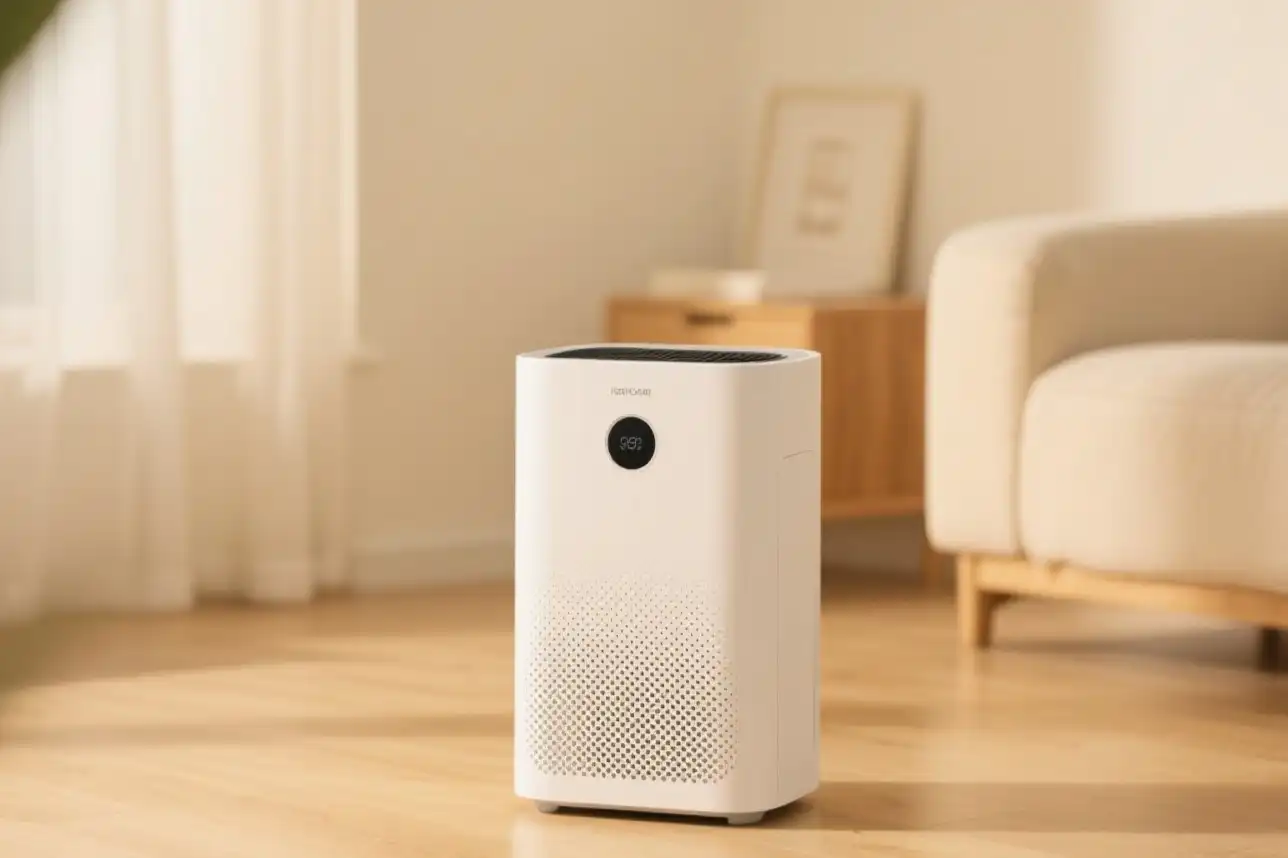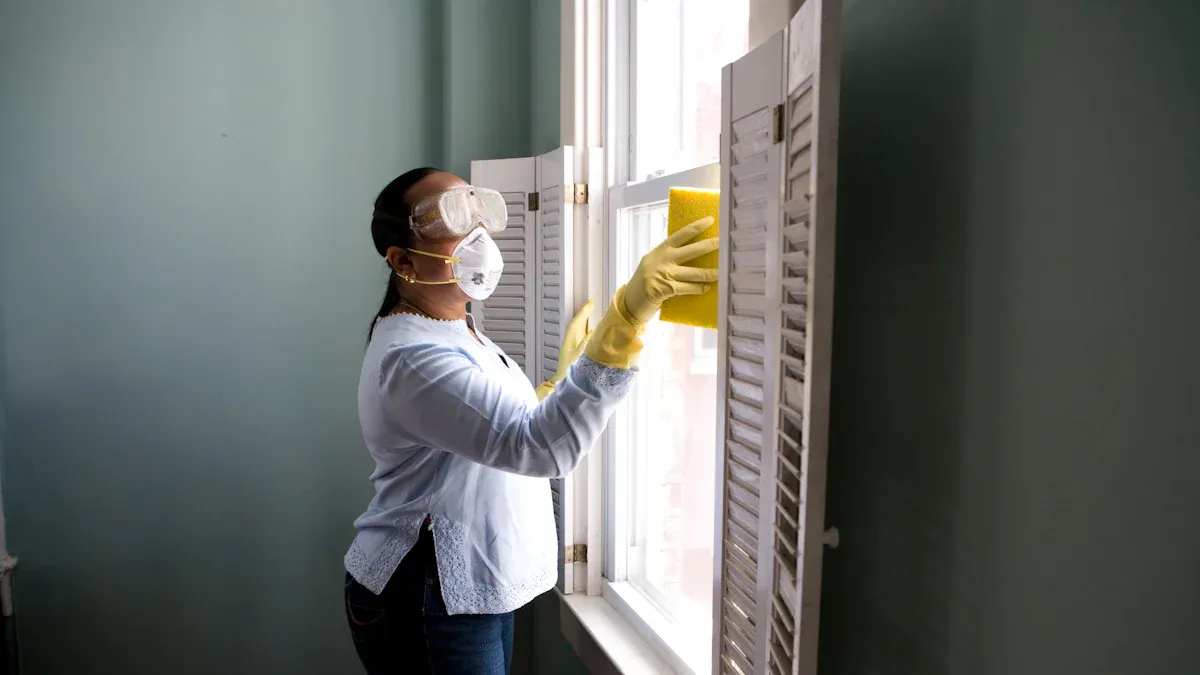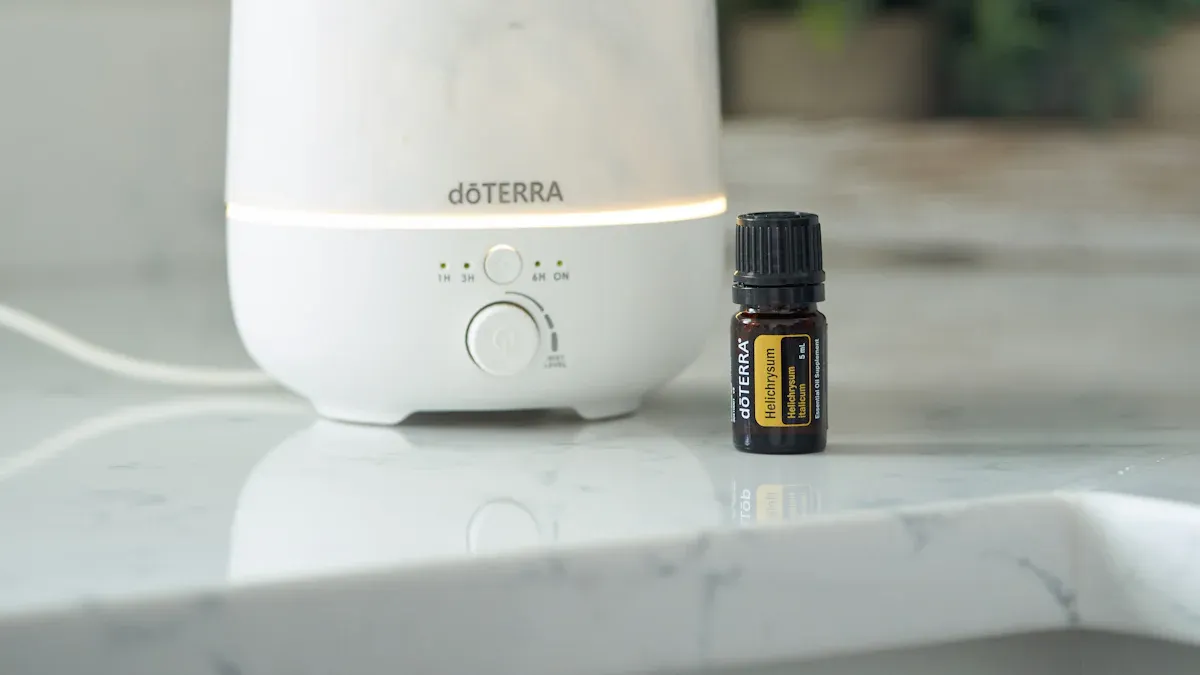
You can make your home healthier with an air purifier. Many families use this tool to take out allergens, dust, smells, and bad particles from the air. Studies show that HEPA filters can cut cat and dust mite allergens by up to 60%. Portable air purifiers also help lower smoke and mold spores inside.
- About 46% of homes with two parents use an air purifier to make indoor air better.
- Families with breathing problems often use air purifiers to feel better.
Cleaner air helps everyone at home breathe easier, feel good, and stay safe.
Key Takeaways
- Air purifiers with HEPA filters take out allergens, dust, pet dander, and mold spores. This makes the air in your home cleaner and healthier.
- Using air purifiers helps lower asthma triggers and breathing problems. This means you may have fewer attacks and can breathe easier.
- Activated carbon filters in air purifiers get rid of odors and harmful chemical gases. This keeps your home smelling fresh and safe.
- Air purifiers with HEPA and UV-C light trap and kill germs. This lowers the chance of getting sick from germs in the air at home.
- Put your air purifier in the right spot and change filters often. This helps it work well and keeps your indoor air clean all day.
Allergen and Dust Control

Air Purifier for Allergens
Every day, you deal with many indoor allergens. Pollen, dust mites, pet dander, and mold spores can make you sneeze or have itchy eyes. Sometimes, they even cause asthma attacks. These tiny things float in the air or land on your bed and furniture. When you use an air purifier with a HEPA filter, it catches most of these allergens. The HEPA filter can trap very small particles, even ones as tiny as 0.3 microns. It works really well, catching almost all of them. This means you breathe in fewer things that cause allergies. You will feel more comfortable at home.
Tip: Put your air purifier in the rooms where you spend the most time, like your bedroom or living room, to get the best results.
Many studies show that air purifiers lower dust mite waste, pollen, and pet dander in the air. People with allergic rhinitis or asthma often feel better when they use a purifier for at least eight hours each day. Keeping the air in your home between 30% and 50% humidity also helps stop allergens from growing.
- Common indoor allergens removed by air purifiers:
- Pollen from open windows and doors
- Dust mites in bedding and carpets
- Pet dander from animals
- Mold spores in damp areas
Reducing Dust
Dust can build up fast in most homes. It lands on shelves, floors, and electronics. This makes cleaning harder and takes more time. An air purifier helps by catching dust in the air before it falls on things. Studies show that using a purifier can lower dust in the air by about 30% to 40% in just one week. Some HEPA filters can even catch up to 98% of very small dust.
| Benefit | How It Helps You |
|---|---|
| Less dust on surfaces | Spend less time cleaning |
| Fewer airborne irritants | Breathe easier, especially with asthma |
| Cleaner air | Improve comfort and health at home |
To keep your air purifier working well, change the filter every 6 to 12 months. Put the device near places where dust comes from or in the middle of the room for the best results. If you use your air purifier often and take care of it, your home will be cleaner and healthier.
Asthma and Respiratory Relief
Removing Triggers
People with asthma or breathing problems know triggers are hard to avoid. Many triggers float in the air inside your house. These include smoke, dust mites, pet dander, mold spores, and viruses. Air purifiers with HEPA filters can trap 99.97% of these tiny things. This makes your air much cleaner.
Tip: Put your air purifier in rooms you use most, like your bedroom or living room, for the best results.
Here are some main asthma triggers that air purifiers can help remove:
- Smoke from cigarettes or wood fires
- Dust mites from bedding and carpets
- Pet dander from cats and dogs
- Mold and fungal spores from damp places
- Pollen from open windows
- Respiratory viruses
Using an air purifier lowers your contact with these triggers. This can help you have fewer asthma attacks and less coughing or wheezing. Studies show kids with asthma who use air purifiers in their bedrooms have fewer symptoms and need less medicine. A 2016 review found portable HEPA purifiers can cut airborne particles by up to 50%. This leads to fewer asthma attacks.
Supporting Breathing
Breathing clean air feels easier and more comfortable, especially if you have asthma, COPD, or allergies. Air purifiers help by removing fine particles and harmful gases that make breathing hard. HEPA filters with a high MERV rating can catch over 99% of tiny particles, including PM2.5, which are linked to poor lung health.
Here are some breathing problems that get better with air purifier use:
- Asthma: Fewer attacks and less wheezing
- COPD: Easier breathing and better lung function
- Allergies: Less sneezing and stuffy nose
| Study & Year | Population & Setting | Intervention | Key Findings |
|---|---|---|---|
| American Academy of Pediatrics, 2016 | Children with asthma | Portable HEPA air purifiers | Reduced airborne particles by 25–50%; decreased asthma symptoms and attacks |
| Shanghai Study, 2016 | Children in high pollution area | HEPA air purifiers in bedrooms | PM2.5 reduced by 33–66%; 73.1% increase in respiratory elasticity |
| 2021 Study | Patients with allergic asthma | Indoor allergen and PM reduction via purifiers | Improved quality of life and symptom reduction |
You get the most benefit by running your air purifier all day and keeping it clean. Do not use ozone generators, as they can make breathing worse. Using a stand-alone air purifier with a good furnace filter gives you even cleaner air. Cleaner air means you can breathe easier and feel better every day.
Odor and Chemical Removal

Eliminating Odors
You can smell many things in your home. Cooking, pets, smoke, and cleaners all make odors. These smells can stay in the air for a long time. Air purifiers with activated carbon filters help get rid of these odors fast. The carbon filter has tiny charcoal pieces with lots of space inside. When air moves through, the filter grabs odor molecules and chemicals. This process is called adsorption. It keeps the smells trapped in the filter.
Air purifiers with activated carbon filters can lower smoke smells from cigarettes, wildfires, and burnt food by over 85%. They also take away more than 90% of chemical odors from household products, paints, and cleaners. Ozone smells can drop by up to 90% when you use these filters. You will have fresher air and a nicer home.
Tip: Put your air purifier close to where the smells start, like in the kitchen or near litter boxes, for the best results.
Lab tests show that air purifiers can take away odors from cooking, pets, and smoke. The table below shows how one test checked the removal of common chemicals that cause these smells:
| Test Aspect | Details |
|---|---|
| Chemicals Tested | Ammonia, Formaldehyde, Limonene, Toluene, Heptane |
| Odor Sources | Pet odors, cleaning products, building materials, paint, cooking, smoke |
| Air Purifier Tested | Oransi TrueCarbon |
| Result | Reduced VOCs and odors from cooking, pets, and smoke |
Filtering VOCs
Volatile Organic Compounds (VOCs) are gases from paints, varnishes, cleaners, and building materials. You cannot see them, but they can give you headaches, make your eyes hurt, and cause other health problems. HEPA filters do not catch VOCs because these gases are too small. Activated carbon filters work best for VOCs. They trap and hold these chemicals, so your air is safer to breathe.
Common VOCs in your home are formaldehyde and benzene. These come from furniture, wood floors, and cleaning agents. Air purifiers with big, high-quality carbon filters remove both reactive and non-reactive VOCs. When you pick an air purifier, look for one with a thick carbon filter and good room coverage. This gives you the best protection from harmful gases and keeps your home smelling fresh.
Airborne Illness Protection
Capturing Germs
There are many tiny threats in the air. These include bacteria, viruses, and mold spores. Air purifiers with HEPA filters help catch these germs. The HEPA filter traps almost all small particles. It can stop things as small as 0.3 microns. This means it catches virus aerosols, bacteria, and allergens. Some purifiers also have a UV-C lamp. The UV-C light breaks the DNA or RNA of germs. This stops bacteria, viruses, and fungi from growing. It works well against strong germs like MRSA, influenza, and mold spores.
Tip: Pick an air purifier with both HEPA and UV-C for the best protection from airborne germs.
Hospitals, schools, and dental offices use these purifiers. They keep the air clean where many people are together. A medical-grade purifier with HEPA and UV-C can cut over 99.9% of germs in one hour. This strong mix helps you feel safe, especially during cold and flu season.
Lowering Exposure
Airborne sicknesses spread fast in shared rooms. When people cough, sneeze, or talk, tiny drops go into the air. These drops can carry viruses and bacteria. In rooms with bad airflow, germs can stay for hours. Air purifiers help by catching these drops and lowering the number of germs in the air.
Studies show HEPA filters remove at least 99% of small particles. This includes things smaller than 0.3 microns, like influenza and coronavirus. In real life, portable air purifiers have lowered germs by up to 64% in nursing homes. They also cut particle levels by 90% in classrooms and apartments. This means you breathe safer air at home, work, or school.
| Setting | Germ Reduction Rate | Air Purifier Type |
|---|---|---|
| Nursing Home | 64% | Portable HEPA |
| Classroom | 90% | Multiple HEPA units |
| Apartment | 80-90% | Portable HEPA |
Using an air purifier helps keep you and others from getting sick. Clean air helps you stay healthy and lowers the spread of sickness in your home.
Better Sleep Environment
Cleaner Air at Night
You spend a lot of time sleeping. The air you breathe at night matters. It can change how well you sleep and feel in the morning. Using an air purifier in your bedroom helps take out bad particles and gases. This makes your air cleaner and helps you rest better. Cleaner air at night helps you sleep deeper and wake up feeling good.
- Breathing air with PM2.5, PM10, or ozone can hurt your sleep. These things can make you wake up more or sleep less.
- Big studies show that less indoor air pollution means longer sleep. It also lowers your chance of sleep problems.
- Lower CO2 inside, from better airflow or air purifiers, helps you sleep well and feel fresh in the morning.
- Cleaner air means less stuffy nose and fewer breathing problems. You fall asleep faster and wake up less at night.
- Air purifiers can help stop snoring by clearing irritants from your airways.
Tip: Put your air purifier close to your bed for best results. Pick a model with a HEPA filter and low noise for quiet sleep.
Reducing Nighttime Irritants
Many things in your bedroom can bother your sleep. Dust, pollen, pet dander, mold spores, bacteria, and viruses float in the air. These can cause allergies or asthma. You might cough, sneeze, or get a stuffy nose at night. Air purifiers with HEPA filters catch up to 99.97% of these small particles. This makes your bedroom air much cleaner.
Common nighttime irritants that air purifiers remove include:
- Dust and dust mites
- Pollen from outside
- Pet dander from cats and dogs
- Mold spores
- Bacteria and viruses
- Odors from pets, cooking, or smoke
A HEPA air purifier helps you breathe easier while you sleep. It can lower allergy or asthma symptoms at night. Carbon filters also take away odors and gases. This makes your room smell better. Using an air purifier at night gives you a healthier place to sleep. You wake up feeling more rested and ready for your day.
Air Purifier Usage Tips
Placement Tips
To get the best results, put your air purifier in the right place. Where you put it changes how well it works. Put your air purifier in the middle of the room for good airflow. Keep it about 3 to 5 feet from walls and furniture. Raise it up to table height so it is close to where you breathe. This helps it catch more dust and pollen. Do not put it in corners or behind furniture. That blocks the air and makes it clean less.
Here is a simple guide for where to put your air purifier in each room:
| Room Type | Best Placement Tips |
|---|---|
| Bedroom | Put it 6 to 10 feet from your bed’s headboard. Place it on a nightstand or dresser. Keep it away from corners. |
| Living Room | Put it in the center, near where you sit. Make sure nothing blocks it, like furniture or electronics. |
| Kitchen | Place it near where you cook or where smells start. Keep it away from heat and vents. Use carbon filters here. |
| Home Office | Put it close to your desk, not behind your computer screen. Keep it about 6 feet from electronics. |
| Basement | Set it on something waterproof, at least 2 feet off the floor. Keep it away from concrete. |
Tip: Put your air purifier near things that make pollution, like windows, pet spots, or doors. This helps it catch dust and allergens early.
Filter Maintenance
You need to keep your air purifier’s filters clean so it works well. Change HEPA filters every 6 to 12 months. If you have pets or allergies, change them more often. Change activated carbon filters every 3 to 6 months, especially if you smell odors or smoke. Many air purifiers have lights that tell you when to change filters.
- Run your air purifier all day to keep the air clean.
- Always pick ozone-free models. Ozone can hurt your lungs and make it hard to breathe.
- HEPA filters catch dust, pollen, and germs. Activated carbon filters take away smells and gases.
| Filter Type | What It Removes | How Often to Change | Notes |
|---|---|---|---|
| HEPA | Dust, pollen, mold, pet dander, germs | Every 6-12 months | Best for allergies and asthma |
| Activated Carbon | Odors, smoke, chemical gases (VOCs) | Every 3-6 months | Best for kitchens and pet areas |
Note: Air purifiers that make ozone can cause coughing, chest pain, and asthma attacks. Always choose ozone-free models to stay safe.
You can make your home safer with an air purifier. It helps you feel more comfortable too. Studies show these devices help you breathe better. They can lower allergy and asthma problems. They also help you get sick less often.
- Air purifiers take out dust, pollen, pet dander, and viruses.
- They lower indoor pollution. They help you sleep better and focus more.
When picking a model, think about your room size. You should also look at the filter type and how much it costs to keep up.
| Benefit | Impact on Your Home |
|---|---|
| Fewer sick days | Up to 40% reduction |
| Allergy relief | 20% fewer symptoms |
| Payback period | 1-2 years |
Spend some time looking for the best one for you. Breathing cleaner air helps you stay healthy and happy at home.
FAQ
How often should you run your air purifier?
You should run your air purifier all day for the best results. This keeps the air clean and helps remove dust, allergens, and germs. Most models use little energy, so you do not need to worry about high power bills.
Where should you place your air purifier for best results?
Place your air purifier in the center of the room or near sources of dust and allergens. Keep it away from walls and corners. Make sure nothing blocks the airflow. This helps the purifier clean the air better.
Do air purifiers help with pet hair and dander?
Yes, air purifiers with HEPA filters trap pet hair and dander. This reduces allergy symptoms and keeps your home cleaner. You will notice less pet hair on furniture and in the air.
Can air purifiers remove viruses and bacteria?
Air purifiers with HEPA filters can capture most airborne viruses and bacteria. Some models use UV-C light to kill germs. This helps lower your risk of getting sick at home.
How do you know when to change the filter?
Most air purifiers have a filter change light. You should also check the filter every few months. If you see dust buildup or smell odors, change the filter. Clean filters help your purifier work better.
See also
How Air Purifiers Maintain Clean Air in Modern Homes
Whether one air purifier can be suitable for multiple rooms
What to Consider Before Putting an Air Purifier in Every Room
